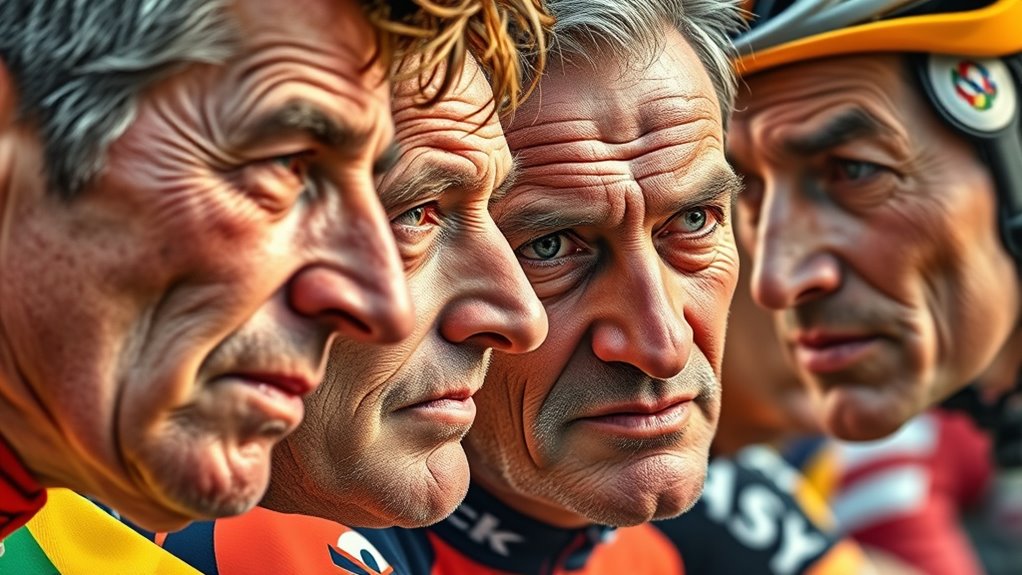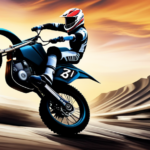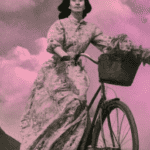In cycling culture, influential figures range from legendary racers like Eddy Merckx, known for over 445 wins, to pioneers like Katherine “Kittie” Knox and Major Taylor, who broke racial and gender barriers long ago. Gravel creators Jim Cummins and Joel Dyke revolutionized adventure riding, while media innovators like Lachlan Morton and the ‘Thereabouts’ series highlight exploration and community. If you keep exploring, you’ll discover how these icons continue to shape diversity, innovation, and social impact in cycling today.
Key Takeaways
- Jim Cummins and Joel Dyke pioneered gravel racing with the Dirty Kanza, emphasizing community, challenge, and grassroots adventure.
- Cycling legends like Eddy Merckx, Fausto Coppi, Jacques Anquetil, and Peter Sagan have shaped endurance, strategy, and racing history.
- Katherine “Kittie” Knox and Major Taylor broke racial and gender barriers, advocating for diversity and inclusion in cycling.
- Media initiatives like ‘Thereabouts’ promote adventure cycling, exploration, and cultural storytelling beyond competitive racing.
- Organizations such as World Bicycle Relief foster social change by providing bicycles to underserved communities worldwide.
Gravel Racing Pioneers: Jim Cummins and Joel Dyke
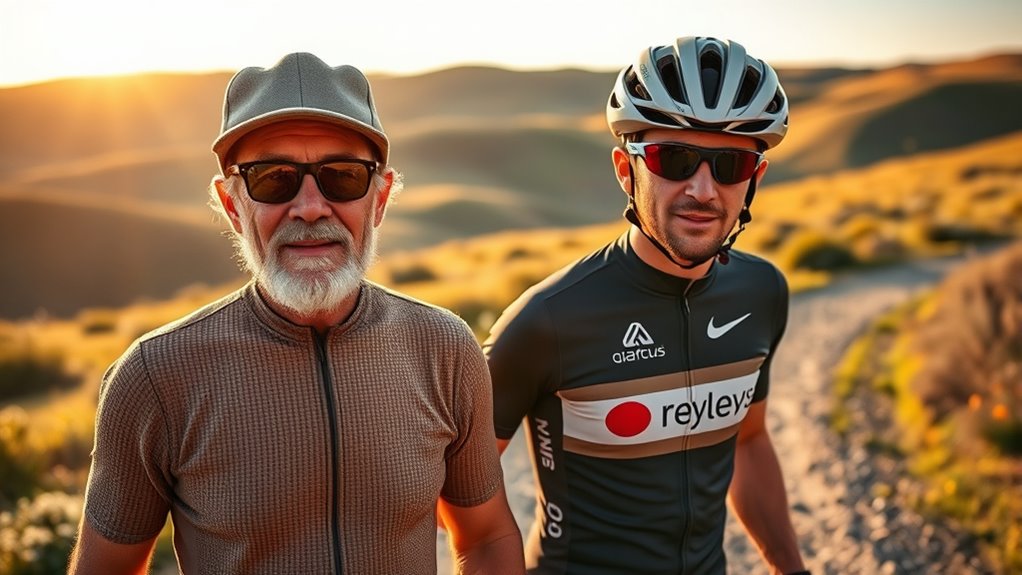
Jim Cummins and Joel Dyke revolutionized gravel cycling by creating the Dirty Kanza, a race born from their shared passion for adventure and grassroots riding. In 2006, they founded Dirty Kanza Promotions to craft an event they wanted to experience themselves.
Inspired by Joel Dyke’s 2005 Trans-Iowa gravel ride, they envisioned a “life-enriching cycling experience” in Emporia, Kansas. Starting as a grassroots effort, the race quickly grew, attracting more riders each year, reaching 2,700 by 2018, including pros like Jens Voigt. Community engagement played a vital role in fostering the event’s growth and sustainability. Additionally, embracing climate control technologies for event logistics can improve comfort and operational efficiency during race days. Utilizing technology advancements has also helped streamline event management and enhance participant safety. Developing a strong brand presence through storytelling helped build a loyal community and attract new participants.
The event became a catalyst for local economic revitalization and a model for accessible gravel racing. They prioritized participant growth, designing courses that balanced challenge and approachability, while maintaining the grassroots spirit that sparked its creation. Understanding aura can also enhance personal awareness and growth, fostering a deeper connection to one’s environment and experiences.
The Media Trailblazer: Lachlan Morton and the Alt Tour Movement
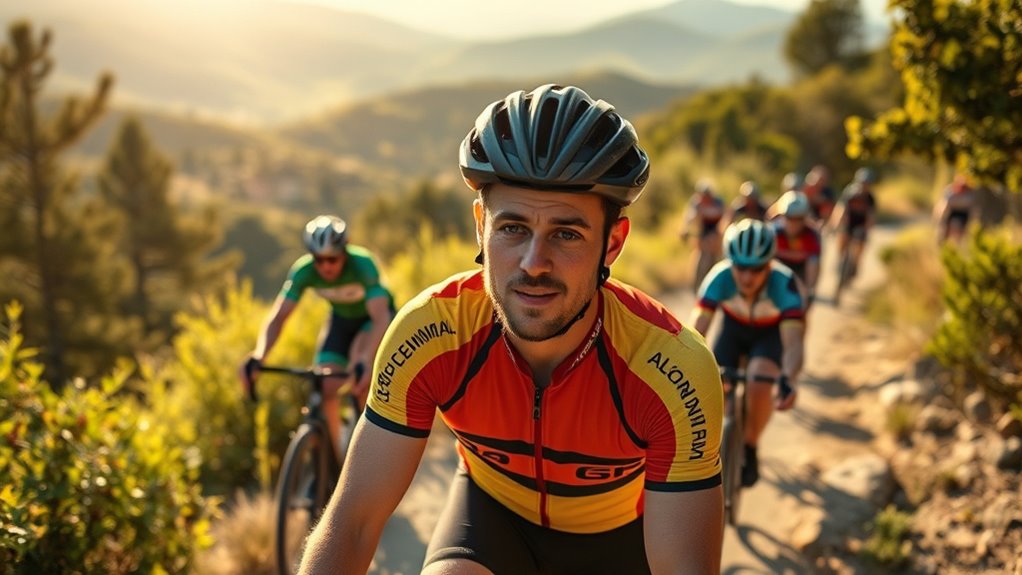
Lachlan Morton has transformed the cycling landscape by pioneering the Alt Tour movement, a series of unsupported, ultra-endurance challenges that push the boundaries of traditional racing.
In 2021, he rode 5,510 km over 16 days, replicating the Tour de France route with transfers, riding 12 hours daily to outpace professional peloton schedules. He self-navigated, carried his gear, and repaired his bike, all while raising over $700,000 for World Bicycle Relief.
Morton shared documentary-style updates via EF Pro Cycling channels, emphasizing transparency and storytelling over competition. His efforts shifted the media focus toward adventure and ultra-distance formats, inspiring grassroots challenges worldwide.
Morton’s storytelling shifted cycling media toward adventure and grassroots ultra-distance challenges worldwide.
This approach not only highlighted cycling’s accessibility but also showcased its power as a tool for social change, redefining how cycling stories are told and consumed.
Advocates for Change: Katherine “Kittie” Knox and Major Taylor
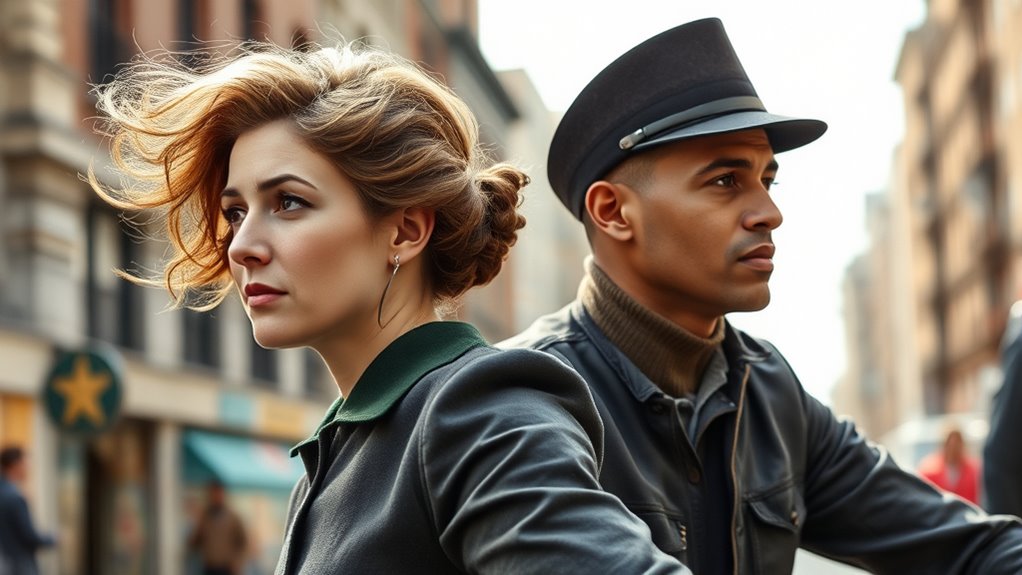
Katherine “Kittie” Knox and Major Taylor stand out as pioneering advocates who challenged racial and gender barriers in cycling, transforming the sport’s cultural landscape. Knox broke racial exclusion by joining the League of American Wheelmen in 1893, despite their “color bar,” and defied their ban at the 1895 meeting, gaining nationwide attention. She promoted practical attire and rode men’s bicycles to challenge gender norms, often outperforming male cyclists and inspiring recognition through awards like the Katherine T. Knox Award for equity. Both figures symbolized resistance, advancing diversity and inclusion in cycling’s evolving culture. Their stories exemplify the profound influence of social change and personal resilience in driving social change within sports communities.
Distributing Opportunity: World Bicycle Relief and Its Impact
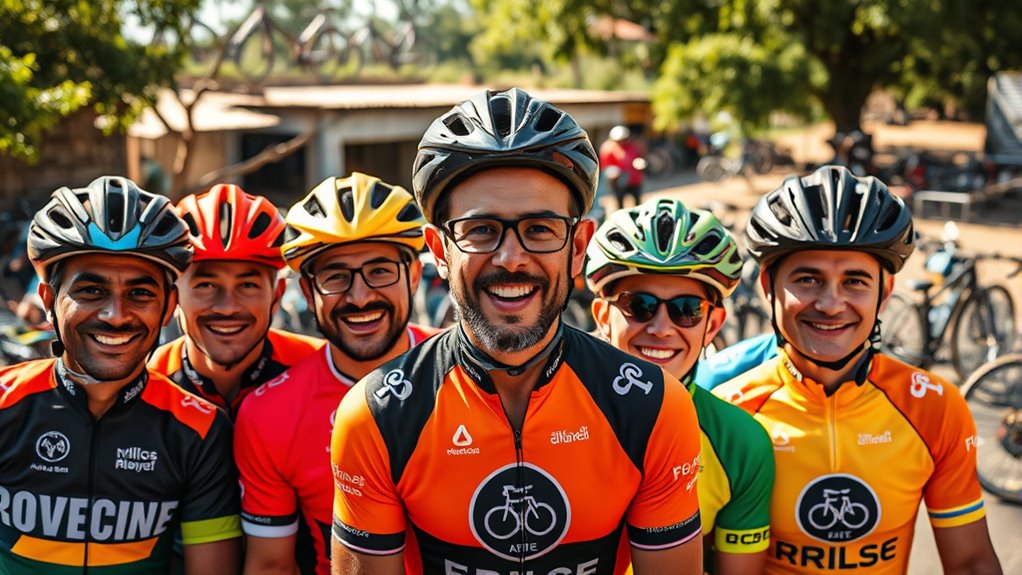
You are trained on data up to October 2023, and organizations like World Bicycle Relief are helping to expand access to sustainable transportation and empower communities worldwide. Their efforts often include distributing durable bikes that serve as vital natural materials for mobility in underserved areas, fostering economic growth and improved quality of life.
Cycling Legends: Eddy Merckx and Fausto Coppi
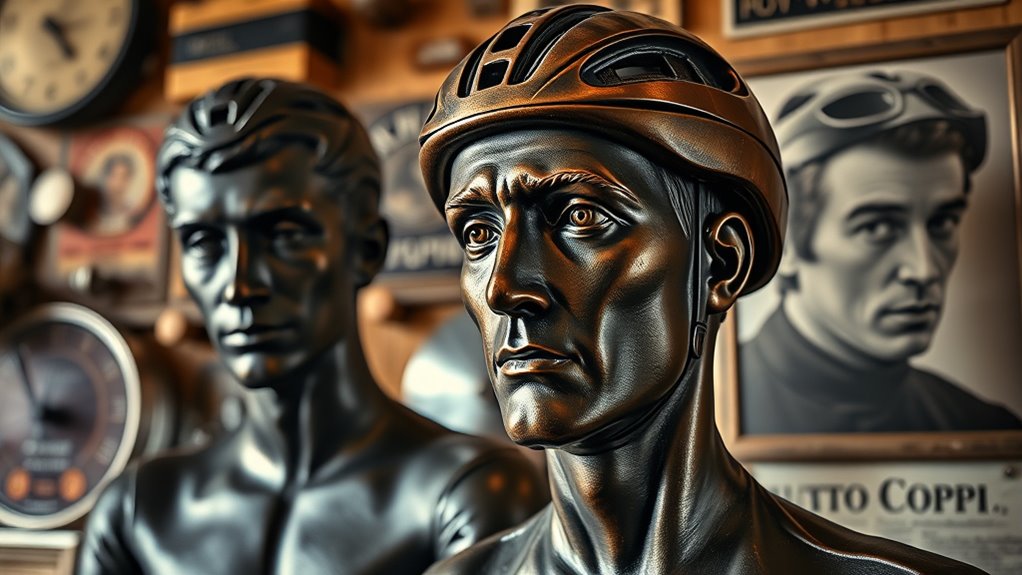
What makes Eddy Merckx and Fausto Coppi stand out as cycling legends is their extraordinary ability to dominate across multiple terrains and race formats. Merckx’s career spanned from 1965 to 1978, with over 445 victories, including five Tour de France wins and 11 Grand Tour victories. He set records in stage wins, classics, and the Hour Record, earning his nickname “The Cannibal.” His aggressive style transformed racing.
Coppi, emerging in the 1940s, won the Giro d’Italia five times by age 20 and made history with the Giro-Tour double in 1949. His innovative climbing techniques and pioneering gear systems revolutionized the sport. Both athletes epitomized versatility and relentless pursuit of victory, shaping cycling’s legacy and inspiring generations with their exceptional achievements and competitive spirit.
Trailblazing Black Athletes: Kittie Knox and Major Taylor’s Legacies
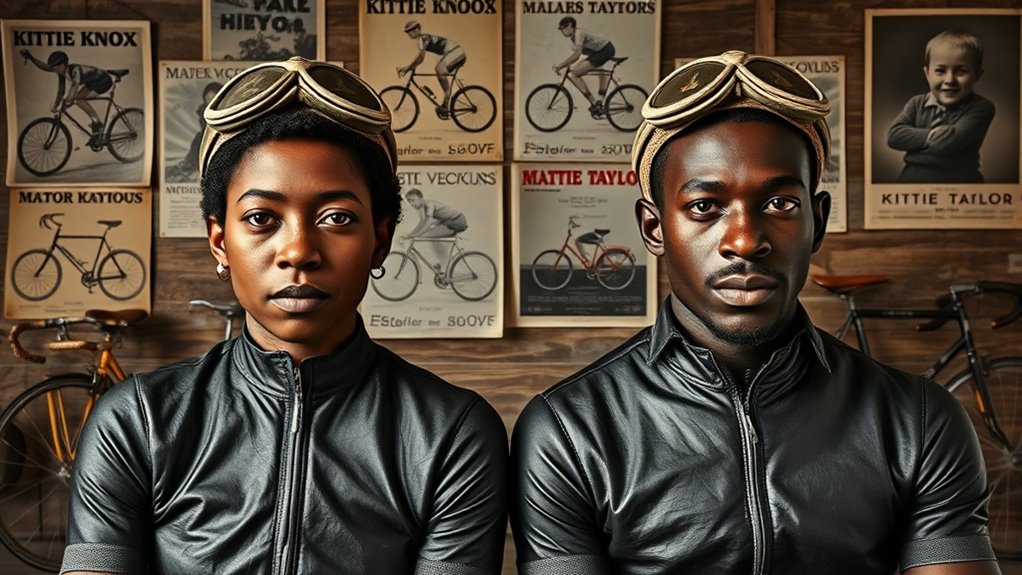
Despite facing immense racial barriers, Kittie Knox and Major Taylor broke new ground in cycling, leaving enduring legacies that continue to inspire today.
Knox, born in 1874, defied discrimination after the League of American Wheelmen changed its rules in 1894 to exclude non-white members. She participated in century rides, challenged gender norms with her fashion, and sparked national conversations on race.
Taylor, born in 1878, became the first African American to win the World Championship in 1899, competing internationally despite hostility and limited support.
Both overcame adversity to achieve remarkable success and challenge racial barriers in their sport. Their pioneering spirits and achievements paved the way for future generations, making them symbols of perseverance, resilience, and the ongoing fight for diversity in cycling.
Champions of Endurance: Jacques Anquetil and Peter Sagan
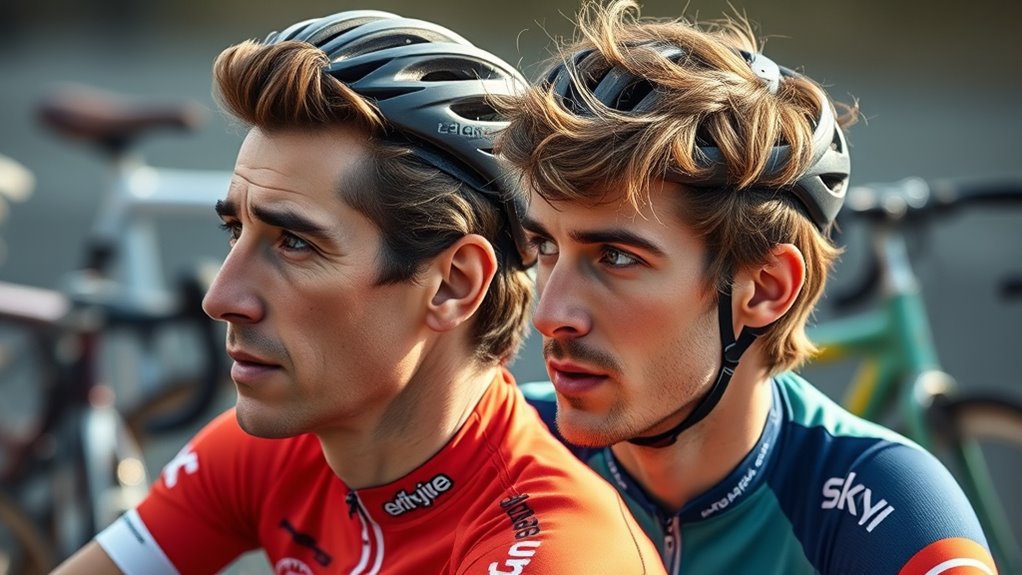
The legacies of trailblazing Black athletes like Kittie Knox and Major Taylor highlight the power of perseverance and breaking barriers in cycling.
Jacques Anquetil exemplifies endurance and strategic mastery, becoming the first cyclist to win five Tour de France titles and all three Grand Tours. Nicknamed “Monsieur Chrono,” he revolutionized time trials with a record nine Grand Prix des Nations wins and a legendary 1961 Tour victory where he wore the yellow jersey from Stage 1.
Anquetil’s scientific training and race-calculating approach set new standards.
Meanwhile, Peter Sagan embodies versatility and resilience, winning seven green jerseys at the Tour de France and claiming victory in classics like Paris-Roubaix. His ability to excel across disciplines and stages makes him a modern endurance champion, inspiring a new generation of cyclists.
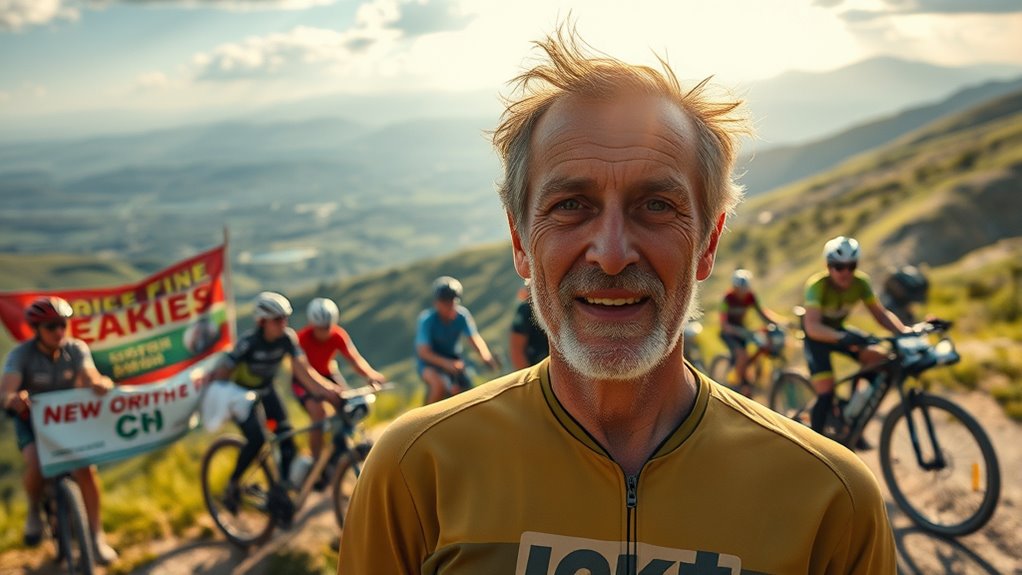
Lachlan Morton’s humanitarian initiatives demonstrate how cycling can serve as a powerful tool for social change. In 2021, he completed a self-supported 3,500-mile ride along the Tour de France route, raising around $700,000 for World Bicycle Relief. This effort funded nearly 4,700 Buffalo Bicycles, helping healthcare workers and students in Colombia and Africa.
His 660-mile non-stop ride from Munich to Ukraine’s border in 2022 raised over $230,000 for Ukraine Crisis Relief, inspiring direct engagement with refugees. Morton’s partnerships with organizations like World Bicycle Relief focus on improving access to bicycles for education and healthcare, especially during COVID-19.
He leverages media platforms like Strava and YouTube for transparency and impact storytelling, redefining cycling’s role in humanitarian work and community empowerment.
Innovators in Cycling Media: The ‘Thereabouts’ Series and Beyond
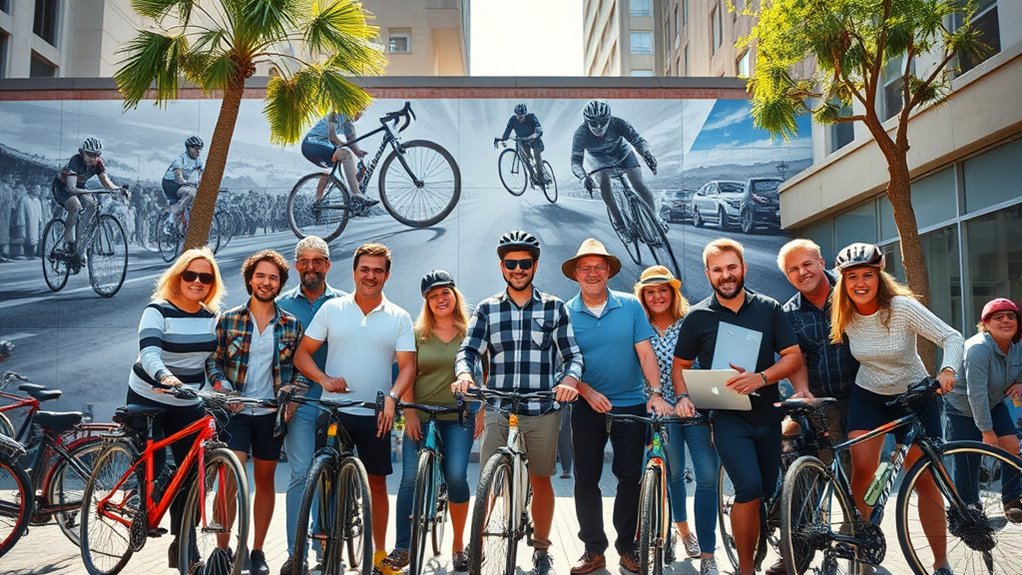
Innovators in cycling media are transforming how we experience and perceive the sport, with the ‘Thereabouts’ series standing out as a prime example. This series emphasizes adventure cycling, showcasing non-traditional routes and cultural immersion, driven by Lachlan and Gus Morton’s professional perspectives.
It highlights the human side of cycling beyond racing, blending stunning landscapes with personal stories in a documentary style. The series has a global reach, exploring environments from Australia to Colombia, fostering cultural exchange and inspiring exploration.
Media outlets like Rapha, Velo Outside Online, and Bike Radar promote the series, expanding its influence. By shifting focus from competition to adventure and community, these innovations inspire viewers to see cycling as a tool for exploration, personal growth, and cultural understanding.
Promoting Equity and Access: Modern Black Cyclists and Advocacy Groups
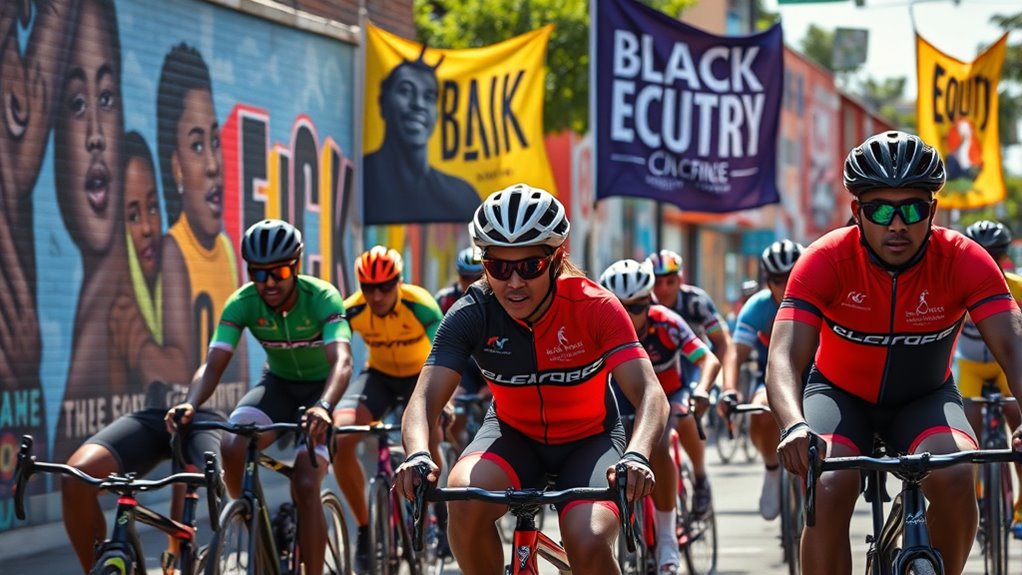
Have you ever wondered how modern Black cyclists and advocacy groups are transforming the sport? Today, they’re breaking down racial barriers and fostering inclusion. Inspired by pioneers like Major Taylor and Kittie Knox, these athletes challenge stereotypes and serve as role models.
Advocacy groups focus on increasing diversity by promoting accessible infrastructure, community programs, and equitable opportunities. They push for safer cycling environments in underserved neighborhoods and support initiatives that make bicycles more accessible.
Media coverage of Black cyclists, such as Biniam Girmay, raises awareness worldwide and encourages participation. Community-building events create support networks for Black cyclists and help reshape cultural perceptions.
Their efforts ensure that cycling becomes an inclusive sport where everyone, regardless of background, can ride, compete, and thrive.
Frequently Asked Questions
How Has Gravel Racing Influenced Mainstream Cycling Culture?
Gravel racing has profoundly shaped mainstream cycling culture by making participation more inclusive and community-focused. You’ll notice a shift toward diverse riders and grassroots events that emphasize camaraderie over competition.
Industry innovations, like gravel-specific gear and disc brakes, appeal to a broader audience. Races now blend terrains, attracting media attention and elevating the sport’s profile.
What Role Did Katherine Knox Play in Racial Integration in Cycling?
Katherine Knox broke barriers, proving that one person can move mountains. She challenged racial segregation by remaining a League of American Wheelmen member despite policies trying to push her out.
Her courage sparked national conversations about racial inclusion and inspired others to follow her lead. Knox’s actions played a pivotal role in promoting racial integration, showing that perseverance can change the game and pave the way for future generations in cycling.
How Does World Bicycle Relief Support Sustainable Development?
You can see that World Bicycle Relief supports sustainable development by distributing bicycles, which improve education, increase employment opportunities, and promote economic growth.
They combine nonprofit efforts with social enterprise models to maximize efficiency and reach.
Bicycles serve as eco-friendly transportation, reduce costs, and foster inclusive communities.
What Are Some Major Milestones in Eddy Merckx’s Cycling Career?
You’re asking about major milestones in Eddy Merckx’s cycling career. You’d note his record 11 Grand Tour victories, including five Tours de France and five Giros d’Italia, and his historic triple crown in 1974.
You’d highlight his dominance in Monuments with 19 wins, including all five classics, and his world championships. His 445 victories and versatility across road and track racing cement his place as one of cycling’s greatest legends.
How Are Modern Black Cyclists Advocating for Representation Today?
You might wonder how Black cyclists today are making their voices heard. They’re challenging barriers through grassroots organizations like Black Girls Do Bike and Major Taylor Cycling Clubs, creating community rides, and mentorship programs that foster growth.
They’re also advocating for visibility, pushing brands for diversity, and fighting systemic racism with policy changes and infrastructure improvements—all while inspiring future generations to see themselves in cycling’s future.
Conclusion
As you explore these influential figures, you witness a vibrant vortex of visionaries shaping cycling’s culture. From fearless pioneers and fierce advocates to media mavens and modern movers, each inspires innovation, inclusivity, and impact. Their stories spark a shared spirit of solidarity, showcasing how passion and perseverance propel progress. Embrace these exemplars’ energy, and let their legacy motivate your own cycling journey—where ambition meets action, and community creates change.
